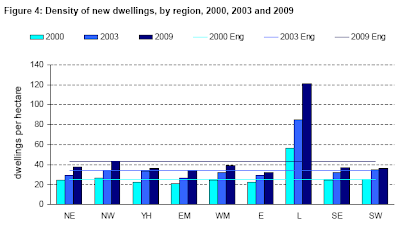London has imposed a huge cost on itself by keeping its height so low — far too low relative to what an incredibly exciting, great city it is. That city could be much more affordable than it is now, and much more inclusive. It has rigidly held to its Victorian building style, particularly for residential. They have allowed some commercial high-rises to go up, which is fairly typical — usually there’s more comfort with building up in commercial zones than there is in residential sectors.That's only partly right. While London has not been building enough homes to make housing much more affordable, a lot is being built, and at high densities. New housing supply has been running at between 25,000 and 30,000 a year since 2003 (see table 15 in this pdf), and building densities have doubled in the last decade, as the chart below shows (source). We have built quite a few high-rise residential towers in the past few years, and there are many more in the pipeline (1).
So I think it's not quite as Prof Glaeser suggests (2), in that we're not still churning out Victorian-style homes (not that Victorian terraces are particularly low-density, mind). But he may still be right that we are not building enough new housing overall, partly due to a concern with not over-densifying existing residential areas - i.e. we're not replacing our existing Victorian terraces with higher-density flats.
If you look at the borough-level supply figures you'll see that the highest supply is in areas with either a lot of ex-industrial land or a relative lack of wealthy home-owners, or both (such as Tower Hamlets). Put another way, it is a lot easier to get homes built where there are either not many neighbours or at least not many of the kind likely to make a lot of noise objecting.
This pattern is worrying for a couple of reasons. Firstly, we will presumably eventually run out of former industrial sites to convert to residential use. Secondly, if incomes keep rising in Inner London and if housing benefit changes help force renters out at the expense of affluent homeowners, we can perhaps expect objections to new housing supply to get more vociferous.
(1) I know, many of the towers at that link are commercial. But many others are at least part-residential.
(2) Note, these figure only go up to 2009. I'm currently working with colleagues in the GLA on the new Annual Monitoring Report, which will have data for 2010.

No comments:
Post a Comment
Note: only a member of this blog may post a comment.